
Understanding Dog Bites: Prevention, Warning Signs, and the Dunbar Dog Bite Scale
Partager
Dog bites are often seen as sudden, unpredictable events but in reality, dogs typically give us multiple warning signs before they escalate to a bite. Learning to recognize those signs, understanding bite severity, and knowing the difference between playful mouthing and serious aggression can help prevent injuries and keep both dogs and people safe.
The Warning Signs Before a Bite
Dogs rarely “snap out of nowhere.” They communicate discomfort or stress through body language, often long before they use their teeth. Recognizing these cues can allow us to step in early.
Early stress signals:
-
Yawning, blinking, or licking their nose (when not tired or eating)
-
Turning head away or avoiding eye contact
-
Turning body away, sitting, or pawing
-
Walking away
-
Whale eye (showing the whites of the eyes)
Escalating signals:
-
Creeping with ears back
-
Standing crouched, tail tucked under
-
Lying down with one leg up
-
Stiffening the body, staring
-
Growling, snapping, then biting
When you see early signs, give the dog space, remove the source of stress, and avoid punishment, which can escalate the situation.
The Dunbar Dog Bite Scale
Created by Dr. Ian Dunbar, this scale is widely used by trainers, veterinarians, and animal control to classify bites based on severity. It’s a tool for assessing risk, guiding training or management, and determining safety measures.
Level 1: Aggressive behaviour but no teeth-to-skin contact.
Level 2: Teeth touch skin but no puncture — a warning snap or inhibited bite.
Level 3: One bite with shallow punctures, no deeper than half the length of the dog’s canine teeth.
Level 4: One bite with at least one deep puncture (more than half the tooth length), possibly with bruising or lacerations.
Level 5: Multiple Level 4 bites, often from repeated attacks.
Level 6: Fatal bite.
Why it matters: Levels 1–2 can often be addressed through training, management, and environment changes. Levels 3–4 indicate reduced bite inhibition and higher danger, requiring strict safety protocols. Levels 5–6 are extremely dangerous and often result in legal intervention.
Play Biting vs. Aggressive Biting
Dogs, especially puppies, use their mouths in play this is normal canine behaviour. However, play biting has key differences from aggressive or defensive biting:
Play Biting/Nipping:
-
Usually happens during games like tug or wrestling
-
The dog’s body is loose and wiggly, not stiff
-
Bites are inhibited you might feel teeth but rarely see deep marks
-
The dog may stop if you yelp, pause play, or redirect to a toy
-
Often accompanied by play bows, relaxed tail wagging, and soft eyes
Full or Aggressive Bite:
-
The dog’s body is stiff, eyes may be hard or dilated
-
Bites may be accompanied by growling, snarling, or snapping
-
Pressure is strong, often leaving puncture marks
-
The dog may latch on, shake, or target vulnerable areas
-
Behaviour is about stopping a perceived threat, not play
Reducing the Risk of a Bite
-
Learn and teach others to recognize early warning signs
-
Supervise children and dogs closely most bites happen at home
-
Respect a dog’s personal space, especially when eating, sleeping, or with a high-value item
-
Provide mental and physical enrichment to reduce frustration and anxiety
-
Address fear, anxiety, and reactivity through humane training methods
Want to Learn More About Dog Body Language?
A great resource is Doggie Language: A Dog Lover’s Guide to Understanding Your Best Friend by Lili Chin. This illustrated guide helps dog owners recognize subtle signs of stress, happiness, and discomfort, making it easier to understand what your dog is really telling you.